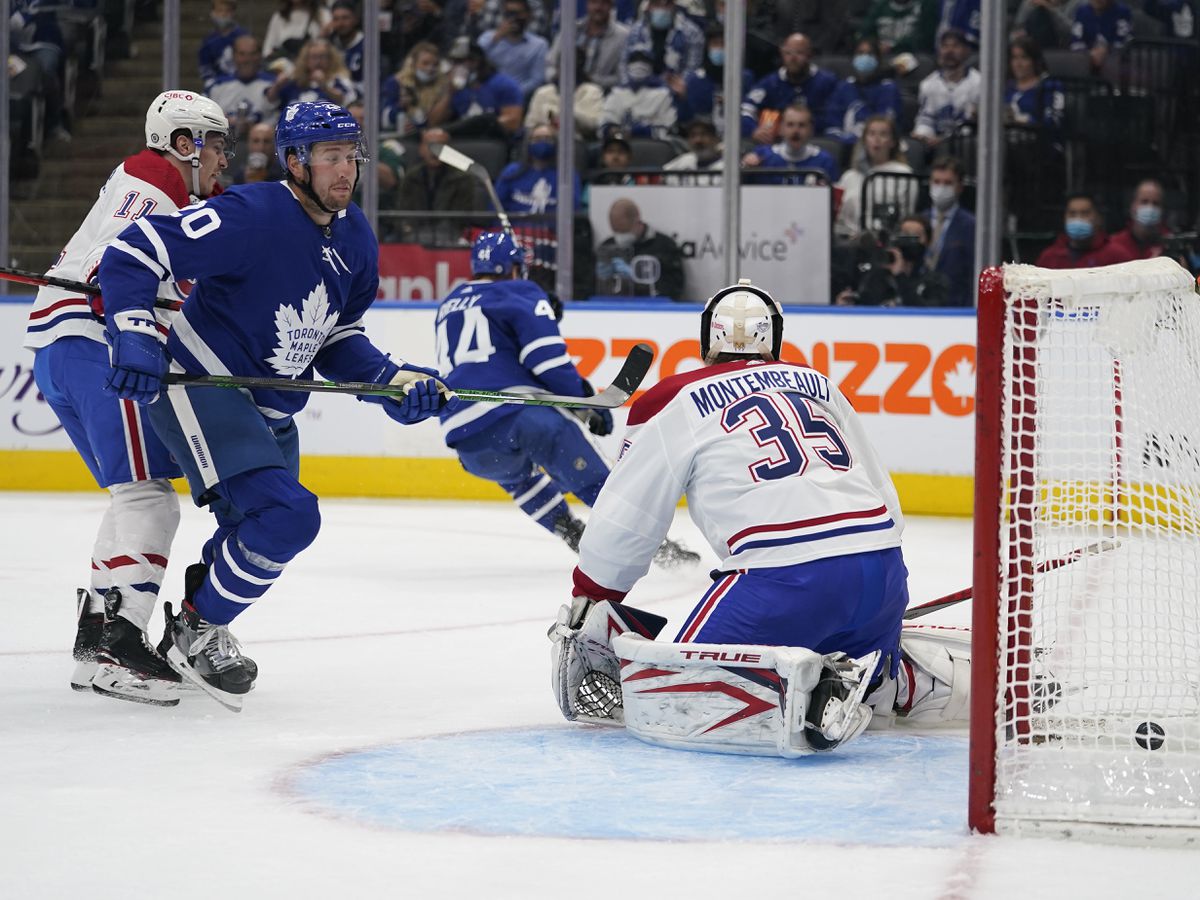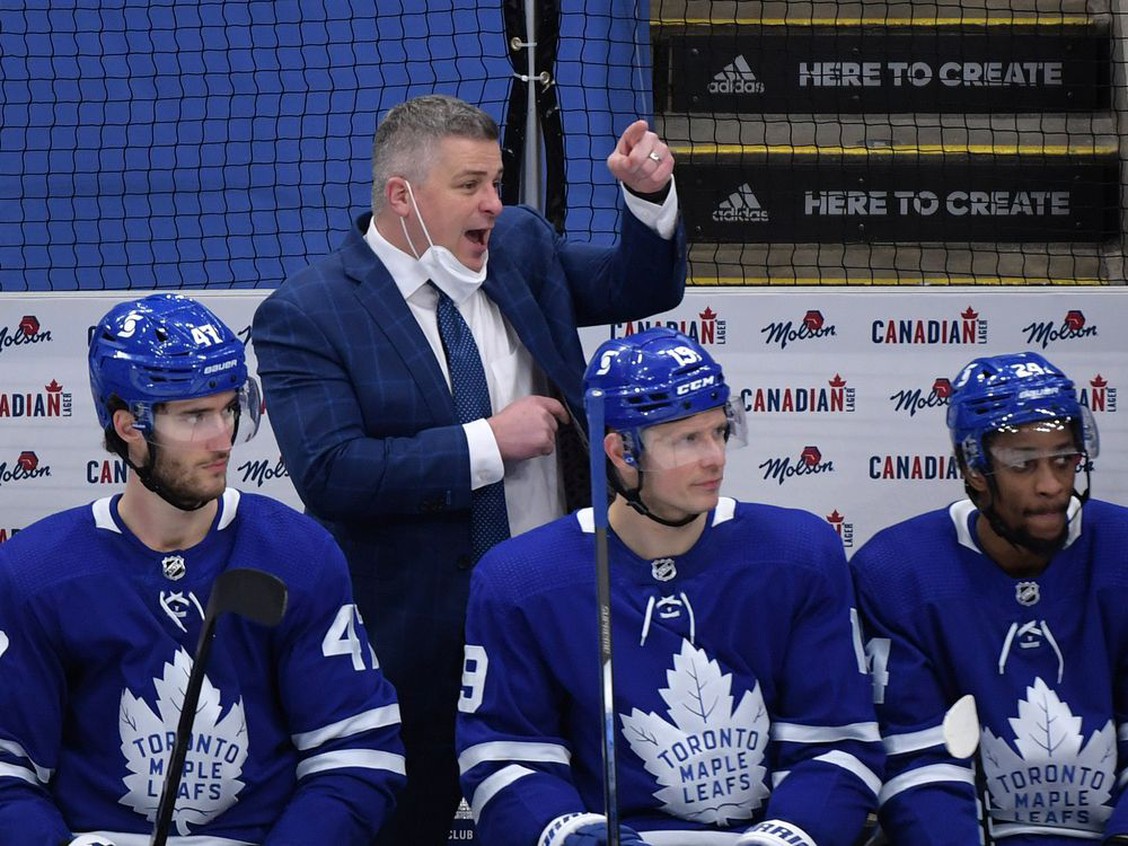The 2021-22 Toronto Maple Leafs certainly have a lot to prove.
The team has lost all five of their playoff series during the Matthews-Marner era, and unlike previous seasons, there was little roster turnover this time around. Petr Mrazek’s $3.8 million cap hit was their most expensive offseason addition, as the team did not add a legitimate replacement for Zach Hyman. With teams like Tampa Bay and Boston back in their division, the Leafs will have their work cut out for them during the regular season once again.
The focus will obviously be on how they perform in the playoffs, but the same can be said for just about any half-decent roster. However, we also need to see the Leafs become a top regular-season team rather than the 2019-20 version that went a mediocre 36-25-9. While it’s undeniable that this team has struggled in the playoffs over the years, it’s worth pointing out that apart from last season’s 56-game campaign against the same six opponents, the Leafs have not been a top-five team in the regular season. There is still plenty of room to grow.
There are a few reasons to be optimistic this season. The power play can’t be much worse, and the playoff lineup should improve if everyone can stay healthy. Their deadline acquisitions will surely be more impactful than Nick Foligno, Riley Nash, David Rittich, and Ben Hutton. They no longer have Ron Hainsey and Nikita Zaitsev playing one billion minutes per night like they did a few years ago.
However, there are still some major question marks on this roster, and given the lack of turnover, it’s tough to convince everyone that the results will be any different. Let’s take a quick look at this roster to see where things stand.
Examining The Leafs Roster

This team is pretty much set in terms of defense and goaltending. Unlike previous years, most of the questions come up front. While they lack a proven star goaltender like Andrei Vasilevskiy or Connor Hellebuyck, they have two options who could be a capable starter come playoff time.
Campbell is still a bit of a mystery box. Goalies are unpredictable in general, but that goes double for Campbell, whose career-high in games played is 31. The last time he played 35 or more games in a season was back in 2016-17 (Matthews’ rookie season), when he played 52 games for the Ontario Reign. While he was great last season, it’s no mystery why the Leafs went out and signed a legitimate 1B option. Having said that, he’s picked up where he left off last year. He sure looks like a quality starter at the moment.
Mrazek is also a bit of a mystery box. The 29-year old was one of the best goalies in the league early on in his career, but he’s had several down seasons over the years as well. He played just 14 games last season between the regular season and playoffs combined. He could end up as a strong #1 starter come playoff time or a mediocre backup, but it feels like the possible outcomes are endless. While getting hurt in his first game was not ideal, there is plenty of time to rebound his season.
For the first time in over a decade, Toronto’s defense was a positive rather than a negative last season. T.J. Brodie proved to be an excellent addition next to Morgan Rielly, and Jake Muzzin was successful at anchoring a shutdown pairing alongside Justin Holl. While the Canadian division was weak overall, there were plenty of good forwards to match up against, and it’s undeniable that the additions of Muzzin and Brodie have improved this group immensely.
The only loss on the back-end is Zach Bogosian, who exceeded expectations last season. He was a steady presence at 5-on-5 and reliable on the penalty kill, but losing a third pairing defenceman shouldn’t exactly make or break a team. While it’s possible that the Leafs take a small step backwards in this area, they should still have plenty of options available to put together a half-decent third-pairing.
Off to a strong start to the season together on the bottom pair, Travis Dermott and Rasmus Sandin bring opposite skillsets to the table. Dermott, 24, has over 200 games of NHL experience, and while he’s yet to establish himself as a true top-four defenseman, he’s posted strong results on the third-pairing in the past. While he’s limited offensively, his transition defense is a strength and it’s tough to beat him out wide. Sandin is the complete opposite, carrying just 37 games of NHL experience, but the Leafs look far more dangerous offensively when he’s on the ice. He’s young and unproven defensively, particularly against top forwards, but it certainly looks like he’ll be a strong third-pairing defender this year at the very least.
Regardless of what happens on the third pairing, the staple of this defense is its top four. One of Morgan Rielly, T.J. Brodie, or Jake Muzzin is the third-best defenseman on this team, and few teams have a better #3. I’m also higher on Justin Holl than most, as he’s graded out well in terms of both goal differential and expected goal differential in back-to-back seasons while matching up against top competition. Muzzin is a major reason for that, but Holl’s size, speed, and strength make him a good fit there, freeing up Brodie to help complement Rielly.
With players like Timothy Liljegren and Alex Biega on the outside looking in, there’s no shortage of depth. The Leafs can trade for a depth defenseman if a need arises, but they have a strong top three, a number four who fit well with Muzzin last year, and plenty of other options who could break out in a big way. You can nitpick, but the biggest hole on this roster is their top-six forward depth.
The Top-Six Problem

This team is built on having two great center-wing duos. Auston Matthews and Mitch Marner both have a chance at 100 points, while John Tavares and William Nylander are first-line players on most teams. At least one of those two duos is likely to win their matchup on most nights, and the team has plenty of decent options for its bottom-six. However, the Leafs never found a real replacement for Zach Hyman, and they won’t have a line with three All-Stars as you’ll see in Colorado or Boston.
There are four forwards on this roster who are clear top-six forwards. That doesn’t mean that everyone else is useless, but no one else would garner a $4 million annual salary on the open market. My guess is that the Leafs will add a top-six forward by the deadline to complement one of their top two lines, but as of right now, there are two spots up for grabs.
Michael Bunting looks like their best option for one of those roles thus far. He’s not a superstar, but there’s enough skill and quickness to look competent in that role and his ability to get to the dirty areas fits nicely there. I’m not going to guarantee that he’ll be in the top-six come playoff time just yet, but so far so good for him.
Nick Ritchie has been terrible. He’s about as slow as Joe Thornton, and he certainly doesn’t have the same passing ability or hockey sense. While he’s good around the net, he’s too slow to be effective on the forecheck. That lack of speed also makes him a liability defensively. He’s been weak in transition, and his penalty differential is usually atrocious. Maybe he’ll end up being a fine bottom-six winger, but so far he looks closer to Jimmy Vesey than a legitimate top-six option.
I can’t say that I’m in love with anyone else as a top-six option, but there are quality bottom-six players. Sheldon Keefe is currently going with a 3A and 3B line rather than a true third and fourth line, a similar approach that he often took with the Marlies. One of those lines is more defensive-minded, while the other looks to take advantage of weaker competition.
David Kampf is off to a great start as their defensive center. A favourite of Sheldon Keefe’s already, Kampf’s been effective at eating up defensive zone starts. His linemates will likely need to carry him offensively, but so far it feels like you can match him up against just about anyone. He’s been good in his role, but his weaknesses are well-known.
Alex Kerfoot’s versatility makes him fairly valuable, but his weak shot limits him offensively. He’s currently bringing a little bit of offensive skill to the checking line, but could also be used as a competent top-six winger or the 3B centre. I think you can move him around based on the team’s needs, but I’m not sure that I’d want to go into a playoff series with both Kerfoot and Bunting in the top-six.
If healthy, Ondrej Kase is likely the fifth-best forward on this team. The 25-year old winger is fully capable of a 40 or 45 point season, but he played just three games last season and his health is a major question mark. He’s currently filling Kasperi Kapanen’s old role as a player who can be a primary goal scorer on the third-line while matching up against top forwards at times as well. Since coming into the league in 2016-17, he ranks 18th out of 355 forwards in shot attempts per minute at 5-on-5 (iCF/60), so he’s a volume shooter who can create some individual offense.
I’m not sure if a shot-first winger will fit nicely with Matthews, but perhaps Kase can slot in next to John Tavares at some point. However, the problem is that he plays primarily on the right side (where the Leafs are deep), and if he moves up, the Leafs will need to find another two-way forward who can drive the checking line offensively.
Ilya Mikheyev, when healthy, is a good checking line player who is limited offensively. His scoring talent definitely holds him back, but I do expect him to improve at least a little bit. However, if he’s in your top six for any length of time, you have a problem.
I’m actually higher on Pierre Engvall at this point, who is a better transition player than Mikheyev and carries a career shooting percentage of 11%. Like everyone else, I’d like him to use his size and strength a little bit more, but his speed and length make him an asset on the forecheck and he brings value defensively. I’ve liked Engvall between Spezza and Simmonds lately, but he was effective with Kampf and Kase as well.
Jason Spezza, who brought plenty of secondary scoring to the table once again last season, will drive Toronto’s third-best scoring line (also referred to as the fourth line). The 38-year old is a key player for the Leafs — both Simmonds and Kampf are weak offensively, so this team will have scoring depth issues if Spezza falls off.
While I still have some questions about the bottom-six — and I’m not sure if Simmonds is one of the top 12 forwards on this team — Simmonds looks a step faster than he was last season. He’s exceeded my low expectations thus far, and I can’t whine about the bottom six quite yet.
The lack of another top-six forward is the clear problem here.
The Big Four

William Nylander has been the Leafs best player this season, and it’s not particularly close. He was probably their best player in last year’s playoff series as well, so I don’t want to hear any complaints about him anytime soon. He’s a star in transition and a dual threat in terms of both shooting and passing. He’s been generating a ton of chances for this team lately.
I am not remotely concerned about Auston Matthews. He generated approximately one billion chances against the New York Rangers in his season debut, and those chances are going to go in eventually. While I don’t think he was amazing on Friday night, he is human, and he went without a proper camp and preseason. There’s no doubt in anyone’s mind that he’s still one of the best players in the league.
This will be unpopular, but I’m not remotely concerned about Mitch Marner, either. If you want to criticize his contract and argue that they’d be better off trading him as a result, I think there are certainly valid arguments to be made. However, I’m still incredibly confident that he’s a star winger who could easily be a point-per-game player so far this season with normal puck luck. He can’t buy a goal right now, but he’s generated plenty of scoring chances for his linemates so far this season. The puck will start going in soon.
Marner is strong defensively, and I’m not remotely concerned about a 24-year old suddenly falling off. He’ll be a top winger in this league for the next decade, and with that kind of ability, he should eventually turn things around in terms of playoff production in the playoffs. However, he did choose to push for every penny and fans have every right to question if he’s a $10.9 million player. I just highly doubt the Leafs will trade him midseason, so personally, I’ll save the majority of the “trade Marner” discussions until the offseason.
In terms of performance, I’m more concerned about Tavares at this point. 31 and coming off a significant injury, he’s not getting any faster with age. He’s looked like more of a high-end second-line center than a Team Canada-calibre player so far, and there’s a pretty significant difference there. I’m sure he’ll still be a valuable contributor, but I question whether he’s the primary offensive catalyst on his line at times.
Ultimately, the Leafs’ big four isn’t going anywhere this season, so I’m more focused on building the best possible team around them at this point. I’m fairly happy with the goaltending (when healthy), the defense, and the Kampf line thus far.
If they can add a legitimate star winger at the deadline, this roster could look quite good in a hurry. Until then, they look like a team with a Zach Hyman-sized hole in their lineup.
Final Thoughts

- Rasmus Sandin looks special offensively, and I want Sheldon Keefe to use him a little bit more. I want to see him out on the ice with Matthews regularly. He should probably play over Rielly with the net empty. You can argue that he should be on the top power-play unit as well, but I think there’s also a case to be made that his shot is more needed on the second unit. He’s been incredibly fun to watch thus far.
- I’m running out of patience with Nick Ritchie in the top six, as I did with Vesey last season. His lack of speed makes him a weird fit on the checking line, so I’d probably play him with Spezza on the fourth line. However, I’d rather play Spezza on the wing, and a Ritchie-Spezza-Simmonds line looks quite weak defensively. That might be their best option for now, but I hope that Ritchie and Simmonds are battling for one lineup spot come playoff time.
- The Leafs could move Kerfoot up in the top six, but I might try a few new things first. If all else fails, I’d reunite him with Nylander and keep Bunting in the other left-wing spot. Something like Bunting-Matthews-Marner and Kerfoot-Tavares-Nylander might be their best option at the moment. I’m also fine with flipping Marner and Nylander, but I’m not overly fussed about that quite yet.
- Sheldon Keefe tried Pierre Engvall with Matthews and Marner on Friday night. I liked that idea. Engvall is much better than Ritchie on the forecheck, where he covers far more ground defensively. While he’s not an elite playmaker, he can back defenders up in transition and create some space for Matthews. I probably won’t want Engvall there come playoff time, but he’s been good offensively this season. Anyone would be better than Ritchie at this point.
- The new top power-play unit hasn’t been great thus far, but I’m curious to see how Marner will do in the bumper spot. For his career, Marner grades out exceptionally well in terms of points per minute on the power play, so it’s not like he can’t be successful with the man advantage. I’m willing to give him a longer look in the bumper spot, but if it doesn’t work, I know he can be successful on the outside of the 1-3-1, particularly on his non one-timer side. If the “Marner in the bumper” experiment fails, I’d probably try to put Nylander there, with Matthews moving to his non-one timer side. If that still doesn’t work, perhaps you just put Bunting in the bumper spot and have Marner run his own unit.

































